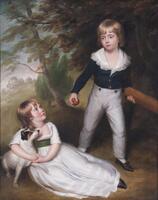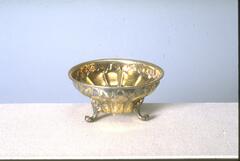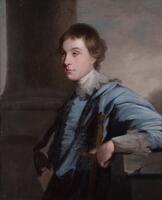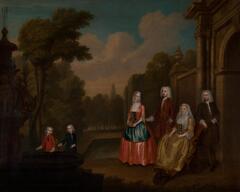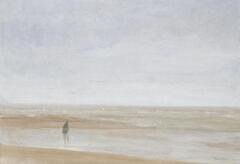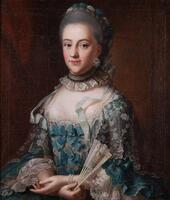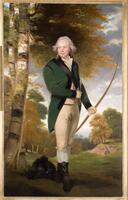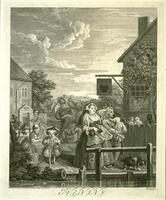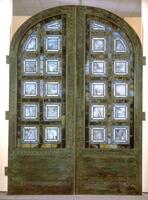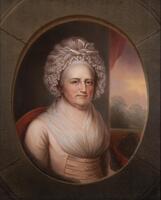The Edwards Family on a terrace
Family business
UMMA Description:
“It depicts the family of Walter Edwards of London (St Dunstans in the West) gathered together in an elegant garden. Walter stands in the middle of the group of adults that includes his wife, Mary, his brother, William, on his left, and a seated older woman, perhaps his mother. Walter’s two sons, Thomas and Walter jnr. stand slightly apart from the adults, seemingly immersed in their own imaginings, one holding a parrot and the other a shell.”
Painting Auction details from 2000
1708-1747 the edwards family on a terrace signed l.l.: CPhilips (in monogram) pinxt 1732 and indistinctly inscribed on a label attached to the stretcher oil on canvas, in a fine carved wood frame 73 by 91.5 cm., 28 3/4 by 36 in. This fine conversation piece shows members of the Edwards family. In the centre is Walter Edwards of St Dunstan's London with his wife Mary, daughter of Richard Freeman of Batsford, Gloucestershire. His brother William stands to the right and the lady seated in a wheelchair is possibly their mother. The two boys on the left are Walter Edwards's sons, Thomas and Walter. Thomas, who was born in c.1726, was the eldest [sic] son and inherited the Batsford estates from his mother's family in 1742, assuming at the same time the additional name of Freeman. He was M.P. for Steyning from 1768 until 1780. Provenance: Commissioned by the Edwards family and by descent to Thomas Edwards Freeman (1726-1808) whose property was inherited by John Mitford, M.P.; Thence by descent to the present owner.
https://www.invaluable.com/auction-lot/charles-philips-156-c-zchrvb42wy
Walter Edwards is with his older brother William and either his mother Jane, or perhaps his elder sister Jane. Walter inherited a fortune in lands and property from his father-in-law through his wife, Mary Freeman via her half-brother, Richard Freeman jnr. The boys are Walter’s young sons, Walter jnr. and Thomas, Walter jnr. being the actual inheritor rather than his father, as a Freeman blood relative through his maternal grandfather. However,at the time of this painting, in 1732 Richard jnr was still the living heir, and all the lawsuits around the Edwards-Freeman inheritance of the great house and lands at Batsford, Gloucestershire, were yet to come.
Walter’s Inheritance
Richard Freeman snr of Batsford, Gloucestershire, whose daughter Mary became Walter’s wife, was a landowner with extensive properties in several counties. The House and lands of Batsford had been inherited through seven generations.
Richard Freeman went to Ireland as Chief Baron of the Exchequer in 1676, and was in 1702 appointed Lord Chancellor of Ireland. Although one of his political rivals complained that he wouldn’t be bribed, and his Protestant peers considered him fair, nonetheless he was part of the ‘Protestant Ascendancy’ in colonized Ireland.
Ireland: Plantations and the Protestant Ascendancy
Ireland was colonised by England from before the time of Henry VIII. Several rebellions were crushed through the 1600’s at great loss of life, and resentment of the “Protestant Ascendancy” was compounded by increasing poverty. The English colonizers established “plantations”, on land seized from native Gaelic chiefs defeated in war. Increasingly from the time of Oliver Cromwell, Protestant, English-speaking Scottish and English settlers were given tracts of land for their loyalty to Cromwell or to the Crown. The AnglicanChurch was the only religious affiliation officially sanctioned. Catholics, Presbyterians, Jews or Quakers were excluded from elected office even if they had sufficient property to qualify, and Catholic landowners were often stripped of their lands.
As a result of their history, Indigenous people in America and the people of Ireland have long held a common bond. Traditional Gaelic culture had been tribal rather than feudal. During the Potato Famine of the 1840’s the Choctaw Indians sent money they could ill afford, to help. The people of Ireland returned the favor recently to help Indigenous people in the U.S. threatened by the Covid pandemic.
Richard Freeman snr’s first wife had died giving birth to their daughter Mary, so his son Richard and daughter Anne were half brother and sister to Mary. But although Richard jnr married, he died young and childless, and Anne was of course female. Like most Wills of the time, a “Tayle [Tail] Male” succession was specified. Whoever inherited the estate of Batsford Park was required to take Freeman as his last name. In those days it was not unusual for a man to take the last name of his wife upon marriage, if her family was more illustrious than his. Thus Walter Edwards became Walter Edwards Freeman.
Bristol
Walter was one of five sons and two daughters of Thomas Edwards snr, Attorney-at-Law of Bristol. Bristol was a thriving port and an important part of the triangular slave trade, bringing manufactured goods such as cloth, ironware, and guns from Manchester and Birmingham to Africa, trading them for enslaved Africans to chain in the ship’s hold to the West Indies and America, and then bringing back Rum, sugar, tobacco, cotton, indigo and other goods from the colonies. Many merchants and shipowners of Bristol became fabulously rich, and one such was Edward Colston, recently made famous when his statue was dumped in the river at Bristol by anti-racist protesters.
Thomas Edwards snr was Edward Colston’s lawyer and general assistant, and probably lucratively debt collector, perhaps reminiscent of the role played by the lawyer Michael Cohen for President Trump. Edward Colston, however, was eager to be known primarily as a philanthropist - and so he was for 300 years, having endowed several schools, almshouses, the Anglican Church and the like. An american visitor to the city in the 1890’s suggested that such an internationally known philanthropist of the city ought to have a statue in his honor, and so it came about.
Walter's parents Jane and Thomas Edwards snr (? - 1727) lived in Bristol, at that time Britain’s second largest city. Thomas Edwards was an attorney with several wealthy clients in addition to Edward Colston. Thomas Edwards snr’s Will is written in a loose cursive hand with no customary devout preamble, which suggests he may have saved the cost of hiring a professional to write it. The Will distributes thousands of pounds worth of bequests to his seven children, and a charitable gift of twenty shillings a year (£1) which includes the preaching of two sermons annually, one on St Thomas’s Day. The Will continues for twelve pages, when one or two were more typical, as Thomas Edwards snr. owned dozens of houses, lands and leases on properties in Bristol and the surrounding regions, specifying the particular succession in each case, usually male primogeniture prioritizing William and any male heirs “by his body begotten”, but with some of exceptions: his very first concern is to ensure that his daughter Jane receives £400 per annum for life. This is reiterated several times - could it be due to her having a disability and using a wheelchair, which would have reduced her marriage prospects? His married daughter is less favored. Another exception is that Walter receives less: “And in case my personal Estate shall amount to more than will pay all my debts and legacies, as I believe it will very considerably if carefully managed, then I appoint the same to be equally divided between my wife and her children by me begotten Except my said Walter having already liberally provided for him.” This suggests that Thomas snr may have been instrumental in brokering the marriage between his son Walter and the older Richard Freeman’s daughter Mary.
Walter’s oldest brother (probably half brother by his father’s first wife) Thomas was married to Mary Hayman, the daughter of Edward Colston’s sister and her husband, another Slave Trader, Sir William Hayman.
Sir William Hayman was a slave trader, major sugar importer and rum distiller, often engaging in illegal activity such as trading in slaves without a licence (the Royal Africa Company had a monopoly) although he later successfully petitioned Parliament to allow a limited number of Bristol merchants to engage in the Triangular slave trade.
Hayman’s business practices were dubious. In a letter to one of his “customers” in Jamaica, he apologises for the inexplicable non-arrival of their order for five men and five women taken from Africa to be sold into slavery, but claims it wasn’t such a bad thing: “we belive it noe way prejudicial to you, notwithstanding your overseer of your plantations Mr Hellyar writes you; for our negroes proved very sicke and dyseased this yeare and [we] lost forty of 120, and the rest were landed very much out of order, and would have been capable of but very little service this yeare, if they had lived...” Hayman was also charged withr kidnapping some white laborers to sell into slavery, and fined £1,000 by the infamous Judge Jeffries who called him a kidnapping knave. Hayman’s brother emigrated to the plantations in Virginia.
Slavery Obscured: The Social History of the Slave Trade in an English Provincial Port ...By Madge Dresser Bloomsbury 2016
Annals of Bristol [17th to 19th Century], Volume 1By John Latimer
The two sons:
The two young boys in the painting are Walter’s sons, Walter and Thomas at the ages of about eight and five. The exotic playthings: the shell containing a pearl, and the parrot may have been gifts from Walter’s sister, their doting Aunt Jane Edwards, who would write to them. They are evidence of the global reach of Bristol’s shipping.
Walter jnr. Would have been the heir to his uncle Richard Freeman Jnr., but Walter Jnr died in his early twenties. The inheritance went instead to Walter’s young brother, Thomas Edwards Freeman.
Smallpox was endemic at that time. Smallpox had wiped out whole communities of Indigenous people all down the East coast of America, such that an early English settler remarked that Providence was showing approval of their colonization by leaving empty villages for them. But although not quite as lethal owing to a degree of immunity, smallpox was commonplace in England as well (the virus was only eradicated in the UK 50 years ago, in the US 70 years ago). Perhaps that was why Richard Freeman jnr and Walter Edwards jnr both died young.
Thomas Edwards Freeman second son of Walter Edwards. Inherited the Batsford estates in March 1742, and assumed the last name Freeman. He married Elizabeth Reveley in July 1753.
Miniature painting
Info provided by the auction house:
Walter Edwards Freeman was the nephew of Richard Freeman (d.1710), from whom he took his last name, and from whom he inherited the estate of Batsford Park, Gloucestershire after the death of the latter’s son, in 1745. [NOTE: the inheritance was settled by law in 1745; Richard jnr’s Will was proved by his widow, Margaret in April 1742]. The connection to Batsford had been strengthened [?] by Walter [snr]’s marriage to Richard Freeman’s daughter Mary.
The family group of enamels by Groth appear to have been commissioned in 1753 and this may have been to celebrate the marriage of Thomas Edwards to Elizabeth Reveley in that year.
Thomas Edwards Freeman
Thomas Edwards Freeman received his Law Doctorate twenty years later in 1763. He married into a high class family and had a son, Thomas Edwards-Freeman II. After gaining a Law Doctorate, he won a Parliamentary seat (unopposed) in the 1768 general election, sponsored by Sir John Honywood, 3rd Baronet a distant relative, and in 1769 became a Director of the South Sea Company.
The South Sea Company, had been created in 1711 to provide enslaved Africans to the Spanish colonies in the Americas (since the Treaty of Tordesillas barred Spain from plundering Africa on it’s own behalf). The South Sea Company was to take over the British Government’s enormous war debt, and then sell shares in its slave trading enterprise to raise funds. After a slow start, the shares became hugely popular with the British public, preceding a spectacular financial crash in 1720 known as the South Sea Bubble - largely caused by corruption. But the Company lost its contract (Asiento de Negros) with Spain in 1733, due to its failure to show accounts and to pay Spain its share of the profits. (See The War of Jenkin’s Ear for more information), but all this was before Thomas Edward Freeman secured his Directorship in 1769.
Whaling
The South Sea Company had pivoted, thanks to government subsidies, into a worldwide Whaling company. It also continued to be a private Finance House to assist the Government in dealing with its war and other debts and obligations leveraging South Sea Company stock.
“Oil was the main product sought from whales, and it was used to lubricate machinery and to provide illumination by burning it in lamps.
When a whale was killed, it was towed to the ship and its blubber, the thick insulating fat under its skin, would be peeled and cut from its carcass in a process known as “flensing.” The blubber was minced into chunks and boiled in large vats on board the whaling ship, producing oil... The "bone" of the whale which was most commonly used wasn’t technically a bone, it was baleen, a hard material arrayed... like gigantic combs, in the mouths of some species of whales... Baleen... act[s] as a sieve, catching tiny organisms in sea water, which the whale consumes as food.
As baleen was tough yet flexible, it could be used in a number of practical applications... Perhaps the most common use of “whalebone” was in the manufacture of corsets, which fashionable ladies in the 1800s wore to compress their waistlines,... Whalebone was also used for collar stays, buggy whips, [parasol spokes,] and toys.”
-- https://www.thoughtco.com/products-produced-from-whales-1774070
For the men working on whaling ships, life was dangerous and extremely tough. Any extra provisions such as bandages or soap were bought from the ship’s store, and crew members could end up penniless at the end of a two year (or longer) trip.
Whales once commonplace, were driven to the brink of extinction by the mid 20th Century.
When Thomas died aged 82, his inheritance passed not to his son (also Thomas, who predeceased him) or to his female relatives, but to the family of his sister-in law, the Mitfords. John Mitford Freeman, (as he then became as a condition of inheriting Batsford) was appointed Lord High Chancellor of Ireland one hundred years after his new namesake had held the position, and was known for his virulently anti-Catholic views.
The famous Mitford Sisters were his descendants; they lived at Batsford during the World War I, but subsequently sold it to the wealthy heirs of the Wills tobacco company, which was founded in1786 in Bristol, where it could easily import tobacco from the Virginia plantations.
What is Landed Gentry?
People like Richard Freeman the elder, or the Dukes of Marlborough come into ownership of land through some means such as a gift of Royalty for suppressing the Irish or fighting the French to attain colonies through peace treaties, or trading in slaves, or the Inclosures Acts, and it continues to make their descendants wealthy for generation after generation.
Thomas Edwards the Elder a Merchant of Bristol and Thos Edwards the younger Esq, and Walter Edwards, gent. mentioned in same document 16 July 1723
https://waalt.uh.edu/index.php/C78_1723
Parties incl as above and MANY more
Content:
re. debts of Charles William, late earl of Suffolk [Charles William Howard, 7th Earl of Suffolk, 1693–1722]; bargaine and sale 31 Mar 1721, the late earl conveyed all his farms, manors, messuages, lands, tenements, rectories, advowsons, woods & hereditaments in the several parishes, hamlets or precincts of Walden [Saffron Walden], Little Walden, Littlebury, Great Chesterford, Little Chesterford, Hadstock, Ashdon, Newport, Widdington, Wendens & Debden in Essex...
Thos Edwards the Elder & Younger and Colston “Edwards v Trye”
https://discovery.nationalarchives.gov.uk/details/r/C10435641
Lawsuits - onee example of many:
Short title: Golding v Edwards. Date of bill (or first document): 1729
Plaintiffs: Timothy Golding of Bristol, Elizabeth Bagwell (wife of Samuel Bagwell), Oriann Whitson (wife of Thomas Whitson), Mary Churchey (wife of Jerome Churchey), (all by Edith Farrer, widow, their mother), and Anne Golding, spinster (another daughter of said Edith Farrer) and said Edith Farrer (late Elizabeth Golding, widow).
Defendants: Jane Edwards (widow and executrix of Thomas Edwards, esq, deceased, late of Bristol), John Burges and William Rogers.
Short title: Edwards v Edwards. 1722 Document type: Depositions.
Plaintiffs: Thomas Edwards the elder esq, Francis Colston esq and others.
Defendants: Thomas Edwards the younger, esq and [unknown] Edwards his wife, Sarah Campbell widow, Mary Edwards and Sophia Edwards.
https://discovery.nationalarchives.gov.uk/details/r/C10440155
Script on plaque at Church in Batsford, Gloucestershire
Heraldic memorial in memory of "Thomas Edwards Freeman esq youngest and only surviving son of Walter Edwards esq by Mary only daughter of the Right Hon. Richard Freeman, Lord High Chancellor of Ireland in the reign of Queen Anne, by Elizabeth daughter of Sir Anthony Keck one of the Lords Commissioners of the Great Seal on the accession of King William & Queen Mary .
Having thro' a long life discharged all its duties in the most exemplary manner , he died on the 15th of February 1808 in the 82nd year of his age , highly respected and deeply lamented.
He left Elizabeth Freeman Heathcote the only child of his only son Thomas Edwards Freeman , his grand daughter & heir. born on the 9th of February 1779 and married on the 27th of June 1799 to Thomas eldest son of Sir William Heathcote of Hursley in the county of Southampton , bart.
On the death of her grandfather and in obedience to his Will , they assumed the name and arms of Freeman in addition to the name and arms of Heathcote. She died on the 16th of March 1808 without issue , lamented by all who knew her , and most by those who knew her best, and was buried in the vault of the Heathcote family at Hursley".
“Mrs Edwards of Redlands Bristol... was a frequent visitor to Bath. She went to Cheltenham in 1742, and was there again fro about 1st August - 6th September 1745, when she paid 2s for a subscription to the walks, and 10s 6d for the weekly hire of a chair
The English Spa, 1560-1815 A Social History By Phyllis May Hembry · 1990
Virginia
Edwards family in Surry County, Virginia USA - could this William be Walter’s Great Grandfather? While Edwards is a common name, not least in this part of Virginia, it is odd that Thomas Edwards the Attorney seems to appear from nowhere. His sons included William, John and Thomas, although again, those are not uncommon names. The social status, connections to the Law, dates and property-loving nature of this family could be a clue. Perhaps there are more clues among the many papers in the Freeman Mitford archive in Gloucester.
https://scholarworks.wm.edu/cgi/viewcontent.cgi?article=5882&context=etd
P7 p26
William Edwards II (?- 1673)appears to have been an affluent member of the county, as he held various advantageous positions such as County Clerk (1653-1673), Burgess (1652-3, 1657-8), Clerk of the Governor’s Council, and was one of the justices of the peace. Using the headright system — where one received fifty acres of land for each person brought to the colonies - he patented substantial amounts of territory. He founded the family home of Pleasant Point, Surry, VA (across the river from Jamestown) and lived there with his wife Dorothy, herself among the headrights he received. William and Dorothy produced at least three sons, William, John & Thomas. At the time of his death in 1673 the family was one of the more prominent names in the county and owned 2,290 acres.
William Edwards III (d. 1698) inherited his father’s estate at Pleasant Point and resided there with his bride, Ann Mansfield, daughter of George Mansfield. He followed his father in service in the House of Burgesses, as well as County Clerk from 1673 to 1698.
Gillray’s much riffed-upon cartoon, “The plumb pudding in danger” 1818
Part of 1 Learning Collection
<p>The most Scandalous woman in Europe, - Spanish p...
<p>Caricature and satire dated 1738</p>
<p>James McNeill Whistler's extraordinary family</p...
Rate this Resource
AVG: 0 | Ratings: 0
& Author Notes
All Rights Reserved (Sophie Grillet)Last Updated
March 12, 2021 6:08 p.m.Report
Reporting Policy
